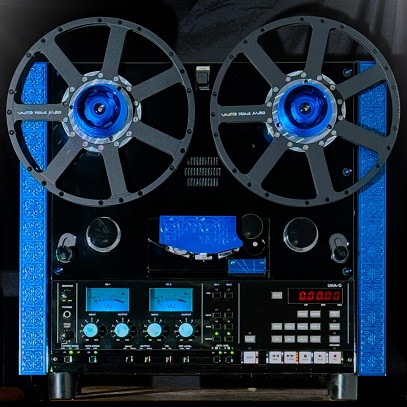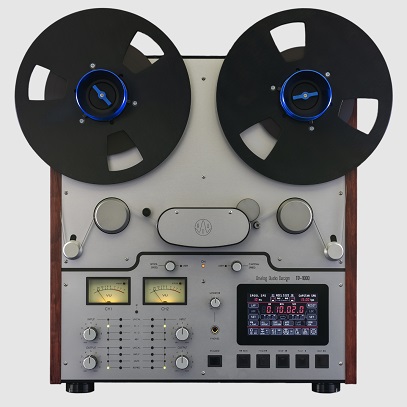THE STUDER A-820: PEAK ENGINEERING OF THE ANALOG ERA
The Studer A-820, introduced around 1984, stands as the pinnacle of Studer’s analog tape recorder development. It was designed to be the ultimate, flexible, and fully micro-processor-controlled analog machine, capable of serving as both a two-track master recorder and a high-channel-count multitrack recorder.
1. Official Model Variations (By Format)
The A-820 was not a single machine but a highly modular platform defined by its interchangeable tape transport components and audio electronics. The model designation primarily reflected the maximum channel count and corresponding tape width it was configured for.
Studer Model Modification:
- A820-2 (Standard): Uses 1/4-inch (6.35 mm) tape for 2-Track Stereo recordings.
Its primary application was Master Recording. - A820-2 (Option): Uses 1/2-inch (12.7 mm) tape for 2-Track Stereo recordings. Its application was Master Recording (High-End), utilizing the wider track for a better signal-to-noise (S/N) ratio.
- A820-MCH: Uses 1-inch (25.4 mm) tape for 8-Track or 16-Track formats. Its primary application was Multitrack Recording.
- A820-MCH: Uses 2-inch (50.8 mm) tape for 16-Track or 24-Track formats. Its primary application was Multitrack Recording (Standard in large studios).
Key Convertible Features:
- Plug-in Headblock System: The machine was designed for rapid conversion between different tape widths (e.g., 1/4" to 1/2" on the Master Recorder, or 1" to 2" on the Multichannel). Swapping the headblock unit automatically triggered the internal micro-processor to load the correct audio and deck alignment parameters specific to that format, thanks to an electronic identifier within the headblock.
- Tape Speeds: All versions supported the professional speeds of 30, 15, 7.5, and 3.75 inches per second (IPS), with CCIR and NAB equalization curves selectable via software.
2. Hardware Variations (Mk-I vs. Mk-II Specifications)
While Studer did not officially label the machines as "Mk-I" and "Mk-II" in the same way as other models, the terminology is widely used to denote machines before and after a critical set of hardware and software updates, particularly those around the 1993 update.
1. Headroom System
- Early Specification ("Mk-I"): Did not include built-in Dolby HX-Pro.
- Late Specification ("Mk-II"): Featured Integrated Dolby HX-Pro capability.
- Significance: HX-Pro required new Record Amplifier cards (e.g., $1.820.811.xx$) to be implemented, enhancing the machine's high-frequency headroom.
2. Skimming Function
- Early Specification ("Mk-I"): The tape Skimming function was either not present or required a separate hardware modification.
- Late Specification ("Mk-II"): The Skimming function was available directly in the machine's service menu.
- Significance: This function is a utility to pass tape slowly over the heads for routine cleaning purposes.
3. Tension Control
- Early Specification ("Mk-I"): Initial versions utilized minor or basic tension and damping algorithms.
- Late Specification ("Mk-II"): Featured Revised motor control loop and tape tension algorithms.
- Significance: This improved the machine's stability and provided gentler handling of fragile tape, particularly during high-speed winding (up to $15 \text{ m/s}$ or $590 \text{ IPS}$).
4. Monitoring Panel
- Both Specifications: Standard equipment included a built-in speaker and headphone jack on the main control panel.
- Significance: The optional large VU Meter Bridge was always a separate accessory. Regardless of whether the bridge was attached, the machine could be operated using the LCD display for status and relying on external console metering for accurate levels.
3. Software Versions (EPROM Updates)
The A-820 used a sophisticated multi-processor system (Master MPU, Tape Deck MPU, Capstan Controller). The firmware was identified by an EPROM part number and a Week/Year (WW/YY) designation. The updates provided refinements to tape handling, control, and new features.
The versions below represent the major milestone software releases found in official Studer update kits:
1. Initial Release
- Version Date: 38/86
- Board: Master MPU (Micro-Processor Unit)
- Part Number (Example): 1.820.996.20
- Key Features / Update: Initial release software, establishing the original A-820 operational standard.
2. Major Stability Update
- Version Date: 06/89
- Board: Master MPU
- Part Number (Example): 1.820.996.22
- Key Features / Update: A significant stability update. It included improvements to the "One-Hand Cueing" response and critical corrections to the Tacho-Error threshold settings.
3. Capstan Control Final Revision
- Version Date: 10/92
- Board: Capstan Controller
- Part Number (Example): 1.820.994.27
- Key Features / Update: The final and most stable firmware for the Capstan Controller, primarily focused on an improved servo loop for precise speed control.
4. The Definitive "Mk-II" Master Firmware
- Version Date: 02/93
- Board: Master MPU
- Part Number (Example): 1.820.996.30
- Key Features / Update: This is often considered the definitive "Mk-II" Master firmware. It added full software support for the new HX-Pro hardware and expanded the Service Menu options to manage these new features.
5. Latest Tape Deck Revision
- Version Date: 35/95
- Board: Tape Deck MPU
- Part Number (Example): 1.820.995.24
- Key Features / Update: One of the latest known stable revisions for the Tape Deck control unit, primarily providing bug fixes and refinement of transport and tension control.
Note on Software and Hardware:
It is crucial to understand that simply having the latest EPROM (software) does not make an "Mk-II" machine. For example, the software version 02/93 must be paired with the updated Record Amplifier Cards (containing the necessary hardware) for the Dolby HX-Pro function to actually work.
4. Operational Configuration (The Missing VU Bridge)
The version you initially described—without the tall VU meter bridge but with the internal speaker—is the standard chassis of the A-820 Master Recorder.
- No Meter Bridge: The lack of the 1.33 meter high meter bridge simply means the operator relied on the Studio Console's Meters for critical level setting and monitoring.
- Internal Monitoring: The small alphanumeric LCD display on the main panel always provides digital readout of the record/reproduce levels, in addition to timecode, locator, and error messages. The built-in monitor speaker and headphone jack provide a low-fidelity reference for cueing and quickly checking for signal presence, not for final audio quality assessment.
In summary, the A-820's strength was its modularity. A single machine could be configured for almost any high-end analog tape format, and its electronic/software platform allowed for continuous feature upgrades throughout its life.




